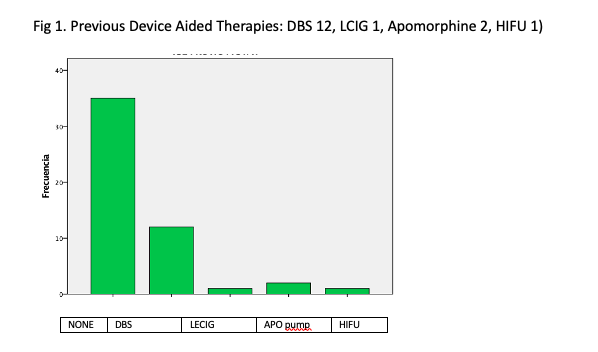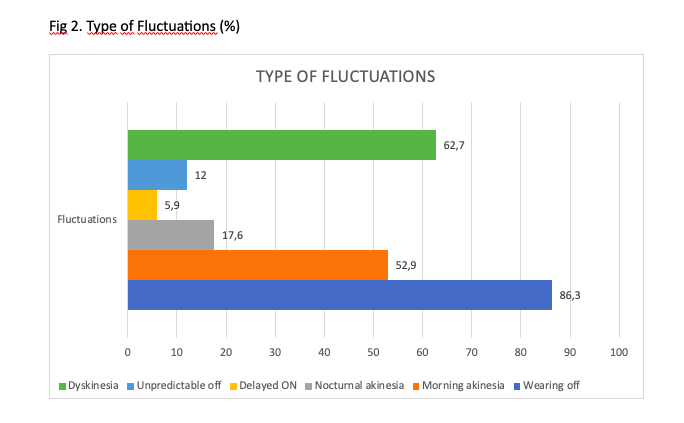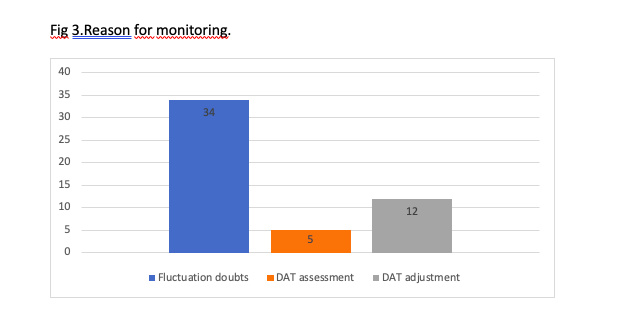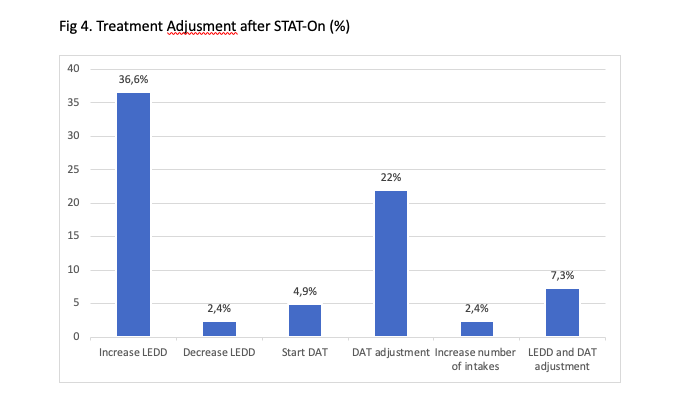Category: Technology
Objective: Analysis of the use of a personalized monitoring device, STAT-on®, to detect motor complications in PDp and its impact on the therapeutic approach.
Background: The symptomatic treatment of PD is effective, but the appearance of motor fluctuations (MF) makes it necessary to optimize the dopaminergic treatment and Houser’s diaries are not always useful in daily practice. One of the most time-consuming tasks in PDp is assessment of MF. Information about clinical status is essential and wearable sensors can help clinicians.
Method:
A single-center retrospective cohort study (Nov 2020-Feb 2023) with PD patients in whom the STAT-ON sensor was used. Demographic variables, variables in relation to Parkinson’s disease, and parameters of the recording have been studied, reasons for monitoring and therapeutic change after registration. Statistics: Mean and standard deviation for quantitative variables, percentage for qualitative; Cohen’s Kappa index for correlation anamnesis-device records
Results: 51 PDp, male 56,9%. Mean age 62,37 +/- 9,8 y, age of onset PD 52,61 (SD 9,99), 84% in stage II H-Y, MDS UPDRS III= 21,3 +/- 12,6, LEDD= 1053,33 +/- 428,6. Advanced aided therapies 12 (fig 1). Symptoms by anamnesis in fig 2, reasons for monitoring in fig 3. STAT-ON recorded MF in all patients. Monitoring time 72.5 +/- 17.11 hours, mean OFF time of 13.9% (10.2 +/- 6.5 hours).of the registry led to a modification in the pharmacological treatment, (fig 4). None of the patients had incidents with the sensor.
Identification of dyskinesias: Better Stat (68,6%) vs patient (62,6%). Unpredictable OFF detection better with sensor (27 vs 6, Kappa I=0,169). The two symptoms were corroborated by patients in the subsequent analysis
Conclusion: The use of STAT on device in daily clinical practice has resulted in a better recognition of fluctuations and dyskinesias for the patient and neurologist, allowing a better pharmacological adjustment.
References: *Pérez-López C, Hernández-Vara J, Caballol N, Bayes À, Buongiorno M, Lopez-Ariztegui N, Gironell A, López-Sánchez J, Martínez-Castrillo JC, Sauco M A, López-Manzanares L, Escalante-Arroyo S, Pérez-Martínez DA, Rodríguez-Molinero A and the MoMoPa-EC Research Group (2022) Comparison of the Results of a Parkinson’s Holter Monitor With Patient Diaries, in Real Conditions of Use: A Sub-analysis of the MoMoPa-EC Clinical Trial. Front. Neurol. 13:835249. doi: 10.3389/fneur.2022.835249
* Santos García D, López Ariztegui N, Cubo E, Vinagre Aragón A, García-Ramos R, Borrué C, Fernández-Pajarín G, Caballol N, Cabo I, Barrios-López JM, Hernández Vara J, Ávila Rivera MA, Gasca-Salas C, Escalante S, Manrique de Lara P, Pérez Noguera R, Álvarez Sauco M, Sierra M, Monje MHG, Sánchez Ferro A, Novo Ponte S, Alonso-Frech F, Macías-García D, Legarda I, Rojo A, Álvarez Fernández I, Buongiorno MT, Pastor P, García Ruíz P. Clinical utility of a personalized and long-term monitoring device for Parkinson’s disease in a real clinical practice setting: An expert opinion survey on STAT-ON™. Neurologia (Engl Ed). 2020 Dec 24:S0213-4853(20)30339-X. English, Spanish. doi: 10.1016/j.nrl.2020.10.013. Epub ahead of print. PMID: 33358530.
To cite this abstract in AMA style:
J. Parra Serrano, MI. Morales Casado, N. Lopez Ariztegui. Analysis of a wearable sensor, STAT-on®, to detect motor complications in patients with Parkinson´s disease (PDp) [abstract]. Mov Disord. 2023; 38 (suppl 1). https://www.mdsabstracts.org/abstract/analysis-of-a-wearable-sensor-stat-on-to-detect-motor-complications-in-patients-with-parkinsons-disease-pdp/. Accessed April 1, 2025.« Back to 2023 International Congress
MDS Abstracts - https://www.mdsabstracts.org/abstract/analysis-of-a-wearable-sensor-stat-on-to-detect-motor-complications-in-patients-with-parkinsons-disease-pdp/




